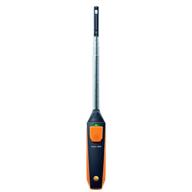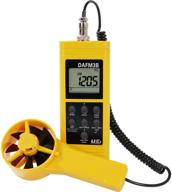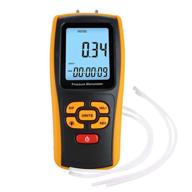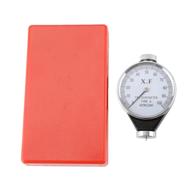How to Use the Hardness Tester?
Using a portable Leeb hardness tester is straightforward once you understand the basic steps. Here is a quick guide to get accurate readings:
Prepare the Test Surface
The area you will test should be clean and smooth. Remove any coatings, rust or debris so the impact body can make good contact.
Insert the Test Bolts
Insert the included test bolts to verify the device is calibrated. The readings should match the bolt hardness values.
Set the Impact Device
- Select the impact device weight based on the expected hardness.
- Tighten the impact device securely.
- Make sure the guide tube is clean and straight.
Measure the Hardness
Hold the meter firmly on the test surface at the desired spot. Press the trigger to release the impact body. The device will display the Leeb hardness value. Take multiple readings in different areas for best accuracy.
Interpret the Results
Compare your hardness readings to the included conversion charts. This will give you common hardness scales like Rockwell, Vickers, Brinell and more. Make sure your readings are within the device's capability for the material you are testing.
With some practice, portable Leeb hardness testers provide fast and reliable measurements to identify materials and detect damage. Just remember to properly prepare surfaces and use the correct impact device for optimal results.
How to Take Accurate Readings?
Taking precise and reliable hardness measurements requires proper technique and an understanding of potential errors. Here are some tips for getting accurate results with your portable Leeb hardness tester:
Proper Impact
- Hold the device firmly perpendicular to the surface.
- Allow the impact body to fall freely onto the test spot.
- Do not restrict or alter the impact movement.
Avoid Errors
| Error Source | Solution |
|---|---|
| Rough or curved surface | Smooth and flatten the test area |
| Too thin or elastic material | Use support or choose different test method |
| Improper impact angle | Keep device perpendicular and stable |
Take Multiple Readings
Perform at least 5-10 tests in the same general area. Discard any outliers and average the consistent middle values.
Use Proper Impact Device
Select the impact body weight suitable for the expected hardness range. Using the wrong impactor can skew results.
Calibrate Frequently
Verify readings on the included test blocks. Recalibrate if necessary to correct any deviations.
With practice and awareness of factors influencing the measurements, the Leeb hardness tester can reliably determine hardness values for quality control, material testing and more.
How to Store Test Results?
Saving hardness readings for documentation or further analysis is easy with the built-in memory and included software.
Device Memory
The hardness tester can store up to 100 groups of data internally. To save results:
- Perform tests as usual.
- When finished testing a particular area, press theMEM button.
- Use the arrow keys to enter a group number (1-100).
- Press ENTER to save results to that group.
To view or delete saved groups, access the memory menu using the MODE button.
Transfer to Software
For more detailed analysis, transfer results to the included LMView software on a PC:
- Connect the tester using the USB cable.
- Open the software and select "Data Download."
- Select which groups to download or click "Download All."
- The data will export into the software database.
In the software you can view data groups, generate reports, export to Excel and more.
Cloud Storage
For remote storage and access from multiple locations, consider a cloud storage service. You can manually export data from the software to upload.
Proper data management allows for record keeping, analysis over time, and data sharing. Combine the built-in memory with software and cloud storage solutions to get the most from your hardness testing results.
How to Connect to Software?
Connecting the hardness tester to a PC allows you to transfer data, generate reports, and get more value from your test results. Here is how to connect to the included LMView software:
Install the Software
First, install the LMView software on a Windows PC. The installer file is typically located on a CD or can be downloaded from the manufacturer's website if needed.
Connect the Hardware
- Use the included USB cable to connect the tester to the PC.
- Power on the hardness tester.
- Allow any driver installations to complete.
Configure Communication
- Launch the LMView software.
- Go to "Settings" and select "Communication."
- Choose "Hardness Tester" as the device type.
- Select the correct COM port that the tester is connected to.
- Click "Test" to verify the connection.
Transfer Data
Once connected, you can transfer data with just a few clicks:
- Go to "Data Download" in the software.
- Select which data groups to download or click "Download All."
- View and work with the data in the software.
The software transforms your hardness tester into a complete material testing system. Connecting it takes just a few simple steps to gain expanded reporting and analysis capabilities.
How to Test Different Materials?
A key benefit of portable Leeb hardness testers is the ability to measure a wide range of metals and alloys. Here are some tips for testing various materials:
Set the Right Impact Device
Select the proper impact body weight for the expected hardness range:
- D for soft metals like copper, aluminum etc.
- DC for harder metals like steel, titanium, iron etc.
- C for very hard metals like tool steel, hardened alloys etc.
Prepare the Surface
Clean and flatten the test area. Remove any coatings or oxidation. Lubricants can also affect readings.
Use Thick, Stable Samples
Very thin materials may deform during testing. Use rigid samples firmly backed by a hard surface.
Consider Material Properties
- Softer metals like aluminum alloy require lower impact energy.
- Harder metals like hardened steel require higher impact energy.
- Cast materials are less homogeneous than wrought metals.
Take Multiple Readings
Perform 5-10 tests in different spots on the same sample. Average the consistent middle values.
With the right impact device, surface prep, and testing technique, the Leeb tester can reliably measure hardness on a wide selection of metals for industrial, manufacturing, and other applications.
How To Use The Portable Leeb Hardness Tester Meter Gauge - HFBTE LM100?
To use the Portable Leeb Hardness Tester Meter Gauge - HFBTE LM100, follow these steps:
- Turn on the device by pressing the power button.
- Select the desired hardness scale from the menu.
- Place the impact device on the surface to be tested and press the button to trigger the impact.
- The device will display the hardness value on the screen.
- Press the save button to store the data in the device's memory.
- Connect the device to a computer and use the LMView software to analyze the data and generate reports.
What Are The Basic Features Of The Portable Leeb Hardness Tester Meter Gauge - HFBTE LM100?
The Portable Leeb Hardness Tester Meter Gauge - HFBTE LM100 has the following basic features:
Other features of the Portable Leeb Hardness Tester Meter Gauge - HFBTE LM100 include a large screen LCD with EL background light, support for micro printers, and the ability to test at any angle, even upside down. The device is also lightweight, portable, and has a long battery life, making it ideal for on-site testing.
What Is The Measuring Range Of The Portable Leeb Hardness Tester Meter Gauge - HFBTE LM100?
The Portable Leeb Hardness Tester Meter Gauge - HFBTE LM100 has a measuring range of (200-960)HLD, which means it can measure the hardness of all metallic materials, including cast steel, alloy tool steel, stainless steel, aluminum, bronze, copper, and cast irons, among others. The device can switch freely between 6 hardness scales, including HB, HRC, HRB, HV, HS, and HL, and can store up to 100 groups of hardness values in its data logger. The device is equipped with an anti-shock jacket, making it shockproof and durable. The LMView software is included for free, which can be used to analyze the data and generate reports. The accuracy of the device is ±6HLD.















